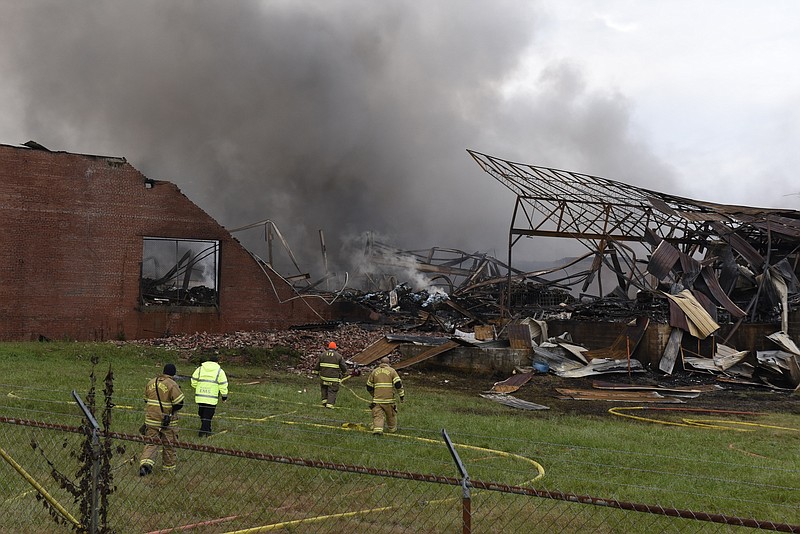We spend plenty of time and energy fearing terrorists, but the real ticking time bombs right next door to us are aging, idled factories and silos used as storehouses for chemicals no one knows how to get rid of.
LaFayette, Ga., is learning that lesson the hard way this week, as smoke so heavy with unknown chemicals and substances forced residents to stay indoors for days as the 50,000-square-foot former Barwick Mills carpet factory continued to smolder for the fourth day.
The air isn't the only problem. Firefighters had to limit the amount of water used on the fire because something in the building was mixing with the runoff and turning nearby streams and the Chattooga River bright blue.
The fact that we have to say "something" was mixing with the runoff and smoke was heavy with "unknown" chemicals and substances is not only frightening, it should be criminal. But it's not.
The nation's environmental laws call for reports and monitoring of chemicals in working factories, but not idled ones. So when an empty business becomes a hulking warehouse for who knows what, neighbors and firefighters have no real way to know what risks might be waiting.
Additionally, the more-than-a-century-old Barwick Mills facility likely contained lots of asbestos - just by virtue of its age and former use. That's certainly not a violation of the law, but it is a real concern for current and future cleanup in the heart of downtown LaFayette.
The federal Environmental Protection Agency is concerned enough to have people on site already, along with a roving air monitor that has collected more than 5,000 air samples to track the particulate-laden smoke plume as winds move it around. Crews also are working to contain runoff from the plant site.
"We are running 24/7 operations," EPA's Carter Williamson told our reporters.
In a town like LaFayette or Dalton, textile and carpet factories with bolted doors are a dime a dozen. Chattanooga, too.
And some of those old plants may well be - like Barwick - a ticking time bomb or a river poisoner. Officials still don't know why the Barwick plant began burning Saturday.
You might recall Charleston, W.V., where a chemical spill tainted water in the 172-mile Elk River, which, after running into the 97-mile Kanawha River, also flows to the Ohio.
West Virginia's Elk River spill in early 2014 was a wake-up call about aging tanks around our aging factories - many sitting right beside rivers because the factories often sent or received goods by river, and they pulled and dumped supply water there too.
So when a decades-old tank in a tank farm on the Elk began leaking, it spilled a very dangerous chemical known as MCHM that is used to wash coal. The spill cut off drinking and washing water to 300,000 people in nine counties downriver of Charleston. That's almost twice the population of Chattanooga and nearly the population of our metro area. The water was off for everyone for five days. No water treatment system would remove the chemical. Boiling the water didn't remove the taint, either.
People were told: Don't drink the water. Don't touch it. Don't wash with it. Don't cook with it. Don't use it for anything except flushing the toilets. The chemical's warning reads: exposure symptoms include severe burning in throat, severe eye irritation, non-stop vomiting, trouble breathing or severe skin irritation such as skin blistering. Health officials said over the weekend that about 170 patients had been treated in emergency rooms for symptoms related to chemical exposure.
That hasn't happened in LaFayette or Chattanooga. Yet. But it's not as unlikely a scenario as we would like to believe. And it's not just an inconvenience: Restaurants couldn't operate. All food manufacturing would have to cease. Other manufacturing where workers come in contact with water as an additive or washing agent also would have to stop.
What's also common is that oversight of many of these storage tanks and idled factories is lax. Very lax. In fact, it's practically non-existent.
Scarier still is that often little is known about the chemicals stored or abandoned in such places. MCHM (4-methylcyclohexane methanol) is a perfect example. In 40 years of use, it hasn't been fully tested. The same is true for some 85,000 other chemicals in commerce right now in the United States.
Why the dearth of information? Why else: Members of Congress have been debating for years whether to update the 1976 law that governs these chemicals, the Toxic Substances Control Act.
Many of our politicians - especially in election years - like to fret about too many regulations on businesses.
Judging by the West Virginia spill and LaFayette's Barwick Mills fire, we don't have enough.
